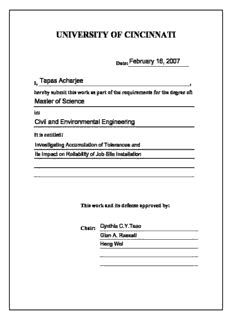
Investigating Accumulation of Tolerances and Its Impact on the Reliability of Job Site Installation PDF
Preview Investigating Accumulation of Tolerances and Its Impact on the Reliability of Job Site Installation
UNIVERSITY OF CINCINNATI Date:___________________ I, _________________________________________________________, hereby submit this work as part of the requirements for the degree of: in: : It is entitled This work and its defense approved by: Chair: _______________________________ _______________________________ _______________________________ _______________________________ _______________________________ Investigating Accumulation of Tolerances and Its Impact on Reliability of Job Site Installation A Thesis Submitted to the Graduate School of the University of Cincinnati In partial fulfillment of the requirements for the degree of MASTER OF SCIENCE In the Department of Civil & Environmental Engineering of the College of Engineering Winter 2007 By TAPAS ACHARJEE A.M.I.E (Civil) - Bachelor of Engineering Institution of Engineers (India), Summer 1999 Committee Chair Cynthia C.Y. Tsao, Ph.D. ABSTRACT Investigating the Accumulation of Tolerances and Its Impact on Reliability of Job Site Installation by Tapas Acharjee Master of Science-Department of Civil and Environmental Engineering University of Cincinnati Cynthia C.Y. Tsao, Ph.D. - Chair Architecture-Engineering-Construction projects may account for product and process design tolerances within drawings and specifications. However, as projects combine a series of components, these tolerances will accumulate. Failure to manage this accumulation can result in component misfits or poor quality of installed work, revealing a lack of product and process design integration. This thesis investigates how tolerance accumulation contributed to breakdowns in bleacher installation on a tennis court project. Building upon earlier work, we create product tolerance, process sequence maps, and generate a tolerance accumulation matrix for a bleacher module to identify components that have the greatest impact on job-site assembly. We discuss how to prevent breakdowns on future projects by restructuring work to enable predictable workflow and achieve better built-in quality. In particular, we explore how to introduce poka-yoke devices as well as changes in contracting, work sequencing, modularity, and new product development to achieve efficient delivery of bleacher systems. TABLE OF CONTENTS 1 INTRODUCTION...........................................................................................................1 1.1 TOLERANCES.........................................................................................................1 1.2 PROBLEM STATEMENT.......................................................................................2 1.3 CURRENT TOLERANCE RESEARCH IN AEC...................................................4 1.4 RESEARCH HYPOTHESES...................................................................................7 1.5 RESEARCH SCOPE.................................................................................................8 1.6 RESEARCH DESCRIPTION...................................................................................9 1.7 RESEARCH METHODOLOGY............................................................................10 1.8 CASE STUDY SELECTION..................................................................................11 1.9 TOLERANCE TERMINOLOGY EXPLAINED...................................................11 2 FUNDAMENTALS OF MANUFACTURING TOLERANCE................................14 2.1 VARIATION AND TOLERANCE........................................................................14 2.2 HISTORY................................................................................................................15 2.3 CATEGORIES OF TOLERANCES.......................................................................18 2.3.1 (GD&T) Size Tolerance..................................................................................19 2.3.2 (GD&T) Form and Profile Tolerance.............................................................21 2.3.3 (GD&T)- Orientation Tolerance.....................................................................22 2.3.4 (GD&T)- Location Tolerance.........................................................................23 2.4 (GD&T)-TOLERANCE ZONES AND ENVELOPES..........................................24 2.5 TOLERANCE RATIONALE.................................................................................28 2.6 ELEMENTS OF TOLERANCING........................................................................30 i i 2.6.1 Datum and datum feature................................................................................30 2.6.2 Datum Reference Frame (DRF)......................................................................31 2.7 TOLERANCE ACCUMULATION........................................................................33 2.7.1 Tolerance Accumulation within Features.......................................................33 2.7.2 Tolerance accumulation in Assembly system.................................................36 2.8 TOLERANCE ANALYSIS....................................................................................37 2.8.1 Sensitivity Analysis........................................................................................40 2.8.2 Variation Analysis..........................................................................................40 2.8.3 Contribution Analysis.....................................................................................42 2.8.4 Tolerance Stack up..........................................................................................43 2.8.5 Assembly Equation.........................................................................................47 2.8.6 Process Capability and General Tolerances....................................................48 2.9 TOLERANCE ALLOCATION..............................................................................50 2.10 CONSISTENCY OF TOLERANCE LOOPS.........................................................53 2.11 VECTORIAL DIMENSIONING AND TOLERANCING (VD&T)......................54 2.12 PRINCIPLES AND PRACTICES OF TOLERANCING.......................................57 2.13 CONCLUSION.......................................................................................................60 3 TOLERANCE MANAGEMENT IN AEC.................................................................61 3.1 AEC LITERATURE ON TOLERANCES..............................................................62 3.1.1 Deficiency in Present AEC Tolerance Research............................................63 3.2 ASSOCIATED AEC LITERATURE.....................................................................65 3.2.1 Constructability...............................................................................................65 ii i 3.2.2 Concurrent Engineering (CE).........................................................................66 3.2.3 Quality in Construction (QiC)........................................................................68 3.2.4 Lean Construction...........................................................................................69 3.2.5 Conclusions.....................................................................................................72 4 CASE STUDY-BLEACHERS INSTALLATION......................................................74 4.1 BACKGROUND.....................................................................................................74 4.2 BLEACHER INSTALLATION: CURRENT PRACTICE.....................................75 4.3 PROBLEMS DOWNSTREAM..............................................................................82 4.4 POSSIBLE SOURCES OF VARIABILITY...........................................................84 4.5 PROACTIVE TOLERANCE VISUALIZATION..................................................86 4.6 PROCESS UNCERTAINTIES...............................................................................88 4.6.1 Variations of Process Constraints...................................................................88 4.7 TOLERANCE REPRENSENTATION AND TOLERANCE NETWORK...........90 4.8 DESIGN AND PROCESS TOLERANCE MAPPING BACKGROUND.............92 4.9 PRODUCT DESIGN TOLERANCE MAPPING...................................................93 4.9.1 Setup Mapping Area.......................................................................................93 4.9.2 Setup and Connect the Nodes.........................................................................94 4.9.3 Assign Values in the Tolerance Frames..........................................................96 4.9.4 Refine and Minimize Constraints...................................................................98 4.9.5 Identify, Evaluate and Check Loop Consistency............................................99 4.10 PROCESS TOLERANCE MAPPING..................................................................103 4.10.1 Process Capability Data................................................................................103 4.10.2 Process Mapping...........................................................................................103 iv 4.11 TOLERANCE ACCUMULATION IN BLEACHERS........................................107 4.11.1 Mechanism of Tolerance Propagation and Accumulation............................107 4.11.2 Worst Case Tolerance Accumulation...........................................................110 4.11.3 Interpretation and Discussion of Results......................................................121 4.12 LEAN TECHNIQUES AND WORK STRUCTURING - INTEGRATED PRODUCT & PROCESS DESIGN......................................................................123 4.12.1 Decouple Dependent Activities....................................................................125 4.12.2 Product Standardization and Modularity......................................................127 4.12.3 Poka Yoke (Error Proofing) of Product and Process....................................129 4.12.4 New Product Development (NPD)...............................................................130 4.13 ABSORBING PRODUCT AND PROCESS VARIABILITY.............................132 4.14 RELIABILITY OF PROCESS TOLERANCE.....................................................134 4.15 VERIFICATION OF RESEARCH HYPOTHESES............................................135 4.16 RESEARCH CONTRIBUTIONS.........................................................................137 5 CONCLUSION...........................................................................................................140 6 FUTURE VALIDATION OF RESEARCH PROCEDURE AND FINDINGS.....143 7 FUTURE RESEARCH...............................................................................................145 REFERENCES....................................................................................................................146 APPENDIX 1.......................................................................................................................152 APPENDIX 2:......................................................................................................................153 APPENDIX 3:......................................................................................................................154 v APPENDIX 4:......................................................................................................................155 APPENDIX 5:......................................................................................................................156 APPENDIX 6.......................................................................................................................157 APPENDIX 7.......................................................................................................................158 v i LIST OF FIGURES Figure 1.9-1: Standard Geometric Tolerances (Henzold 1995)..............................................12 Figure 1.9-2: GD&T System (Henzold 1995)........................................................................13 Figure 1.9-3: VD&T System (Henzold 1995)........................................................................13 Figure 2.3.1-1: GD&T tolerances (Milberg 2006, based on Henzold 1995)..........................20 Figure 2.7.1-1: Linear tolerance accumulation between features within part (Based on Milberg 2006).........................................................................................................................34 Figure 2.7.1-2: Linear accumulation between features with tolerance zone (Based on Milberg 2006).......................................................................................................................................36 Figure 2.7.2-1: Linear tolerance accumulation between features in assembly (Based on Milberg 2006).........................................................................................................................37 Figure 2.8-1: Tolerance analysis (Drake 1999)......................................................................38 Figure 2.9-1: Tolerance specification by tolerance allocation- (Drake 1999)........................50 Figure 2.11-1: VD&T System (Milberg 2006, based on Henzold 1995)...............................55 Figure 4.1-1: Installed bleachers (Acharjee 2006)..................................................................74 Figure 4.2-1: Supporting frame arrangement for bleachers (Acharjee 2006).........................76 Figure 4.2-2: Concrete piers built over the concrete floor (Xu 2007)....................................77 Figure 4.2-3: Base plates set over the piers (Xu 2007)...........................................................78 Figure 4.2-4: Support frame over the piers (Xu 2007)...........................................................78 Figure 4.2-5: Cross bracings added to rear vertical support (Xu 2007)..................................79 Figure 4.2-6: Decking frames added to the support frame (Xu 2007)....................................79 Figure 4.2-7: Decking platforms erected on the decking frame (Xu 2007)............................80 Figure 4.2-8: Cover panels added to the support frames (Xu 2007).......................................80 vi i
Description: